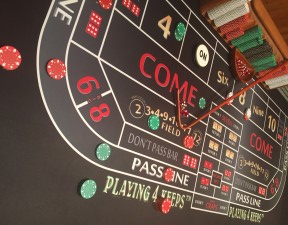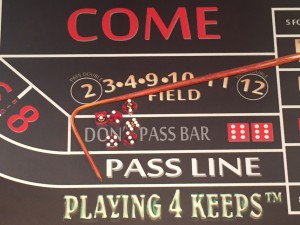Playing 4 Keeps® Craps Appendix
The Game of Craps Overview
1. Pass Line Bet
a. 7 or 11 natural winner, pays even money
b. 2-3-12 natural loser
c. pays even money when the point is repeated before a seven
d. contract bet
2. Pass Line Odds Bet
a. double odds preferred play
b. 3x, 4x, 5x – requires appropriate bankroll for multiple odds
c. pays true or exact odds 6:5 on 6/8, 3:2 on 5/9, 2:1 on 4/10
d. player controls the bet
3. Come Bet
a. 7 or 11 natural winner, pays even money
b. 2-3-12 natural loser
c. pays even money when the number is repeated before a seven
d. contract bet
e. can take odds bet, similar to pass line bet
4. Place Bet
a. player chooses a number or numbers to bet 4-5-6-8-9-10
b. pays house odds when the number is repeated.
c. odds are 7:6 on 6/8, 7:5 on 5/9, 9:5 on 4/10
d. player controls the bet, player may “press” the bet with winnings or remove bet at any time.
e. loses when the seven rolls, except on a come-out roll. The bet is off on a come out roll.
5. Field Bet
a. one roll bet, 16 ways to win, 20 ways to lose.
b. pays even money 3-4-9-10-11
c. pays double for 2 and 12
6. Hardway Bets
a. 4 / 6 / 8 / 10
b. one way to win – pairs only
c. pays house odds, loses to a 7 or any easy way combination
d. player controls the bet
7. Proposition Bets
a. one roll bet that the number bet rolls next, pays house odds, high vig
b. C and E bet, craps / eleven
c. horn bet, making a bet covering 2,3,12, and 11
8. Don’t Pass
a. 2 or 3 craps a natural winner on the come out, bar or push the12
b. 7 or 11 natural loser on the come out
c. pays even money when the seven rolls before the point.
d. player controls the bet and may pick up the bet any time.
9. Don’t Pass Lay Odds
a. lay odds against the point.
b. lay 6 to win 5 on 6/8, lay 3 to win 2 on 5/9, lay 2 to win 1 on 4/10
c. pays true odds.
d. player controls the bet
 In order to fully understand the movement of chips and how bets are paid, you must know the math. The good news is that it is third grade math, not quantum physics. There two parts to the math, True Odds and House Odds. True Odds are the exact and true ratios of the possible number combinations compared to the number of combination of a seven. Example: There are six possible combinations for a seven and five possible combinations for a 6 or 8 to roll. Thus the True Odds for the 6 or 8 to roll, expressed as odds, is 6 to 5. Six ways to lose to the seven and five ways to win rolling the 6 or 8.
In order to fully understand the movement of chips and how bets are paid, you must know the math. The good news is that it is third grade math, not quantum physics. There two parts to the math, True Odds and House Odds. True Odds are the exact and true ratios of the possible number combinations compared to the number of combination of a seven. Example: There are six possible combinations for a seven and five possible combinations for a 6 or 8 to roll. Thus the True Odds for the 6 or 8 to roll, expressed as odds, is 6 to 5. Six ways to lose to the seven and five ways to win rolling the 6 or 8.
The House Odds are figured with vigorish, “house advantage” and you will quickly notice that House Odds are not as good of a payoff compared to True Odds. You will need to memorize both the True Odds and House Odds as you complete your journey through the craps lessons.
| 4 | 5 | 6 | 8 | 9 | 10 |
| 2 to 1 | 3 to 2 | 6 to 5 | 6 to 5 | 3 to 2 | 2 to 1 |
| Pays 2 units for every 1 unit bet | Pays 3 units for every 2 units bet | Pays 6 units for every 5 units bet | Pays 6 units for every 5 units bet | Pays 3 units for every 2 units bet | Pays 2 units for every 1 unit bet |
| 4 | 5 | 6 | 8 | 9 | 10 |
| 9 to 5 | 7 to 5 | 7 to 6 | 7 to 6 | 7 to 5 | 9 to 5 |
| Pays 9 units for every 5 units bet | Pays 7 units for every 5 units bet | Pays 7 units for every 6 units bet | Pays 7 units for every 6 units bet | Pays 7 units for every 5 units bet | Pays 9 units for every 5 units bet |
There are six sides to a die and with two dice; there are thirty-six combinations possible. Below is a table of the thirty-six possibilities for rolling the eleven numbers. Theoretical Probability.
| Number | Dice Combinations | Possibilities |
| 2 | 1-1 | 1 |
| 3 | 1-2, 2-1 | 2 |
| 4 | 1-3, 3-1, 2-2 | 3 |
| 5 | 1-4, 4-1, 2-3, 3-2 | 4 |
| 6 | 1-5, 5-1, 2-4, 4-2, 3-3 | 5 |
| 7 | 1-6, 6-1, 2-5, 5-2, 3-4, 4-3 | 6 |
| 8 | 2-6, 6-2, 3-5, 5-3, 4-4 | 5 |
| 9 | 3-6, 6-3, 4-5, 5-4, | 4 |
| 10 | 1-3, 3-1, 2-2 | 3 |
| 11 | 5-6, 6-5 | 2 |
| 12 | 6-6 | 1 |
The odds are expressed as a ratio of the number of ways of rolling divided by the total possible combinations. Examples: There is one possible combination for 12 to roll 6-6, thus the odds of 12 rolling is 1/36. There are six possible combinations for 7 to roll, thus the odds of a 7 rolling are 6/36 or 1/6.
True odds are an expression of the number of possible winning combinations to the number of losing combinations of the seven. Example: For the 6 or 8 the true odds are 6 to 5. Six ways of losing to five ways of winning.

The “Do’s and Don’ts of Dice Playbook” is a comprehensive guide that offers strategic insights into the game of craps. It emphasizes a disciplined approach to betting, money management, and bankroll protection. The playbook also delves into applied metaphysics, aiming to enhance perception and decision-making at the table. With strategies for both the Pass Line and Don’t Pass Line, it’s designed to help players make informed bets with the best possible return, minimizing exposure to house odds. For those looking to refine their craps strategy, this playbook could be a valuable resource.
Return to How to Play Craps Table of Contents
Copyright © 2006-2024 Michael Vernon – Playing 4 Keeps®

